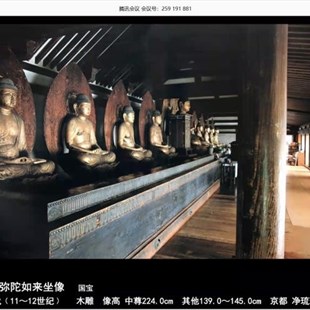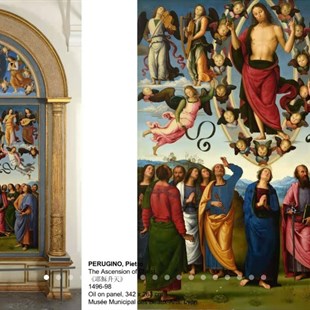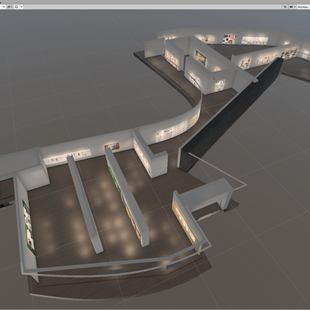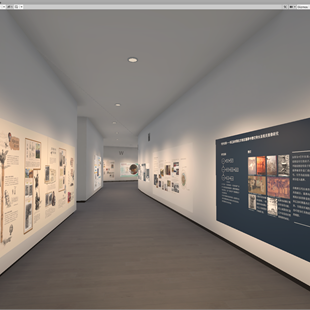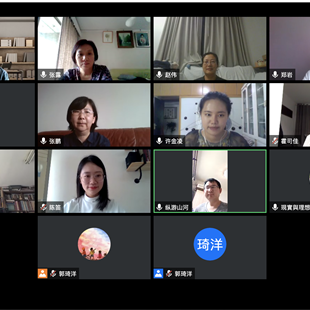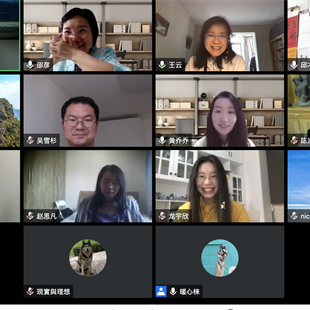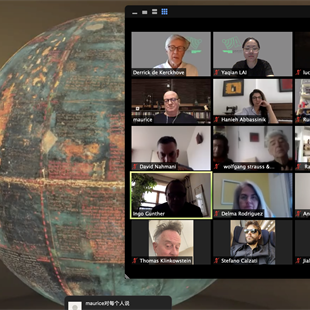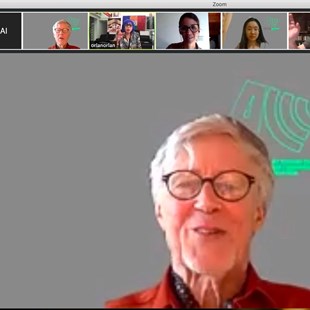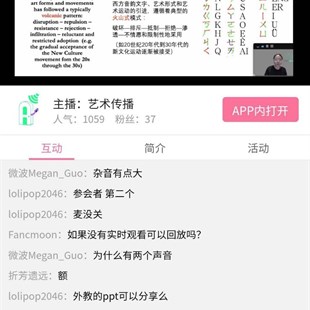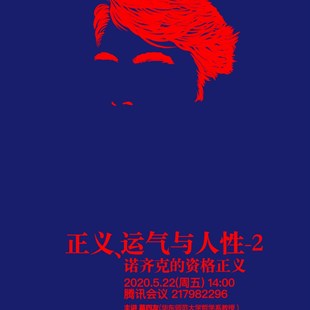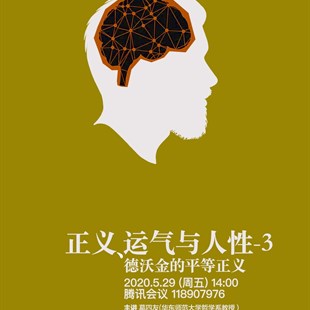
Editor’s note: On May 20th, CAFA Online Graduation Season was officially launched. Within the first 24 hours, online browsing exceeded 2.13 million, and the number of individual visitors reached 530,000. This graduation exhibition has attracted global participation and attention. Offline exhibitions can collect feedback from the audience as soon as they visit, and they can accurately receive information from the art market and then become a stage for an exchange and learning between students ... In comparison, we know very little about the online graduation exhibition. How do teachers from CAFA look at this new form of graduation exhibition? How do they guide students to create? What challenges did they encounter? CAFA ART INFO has interviewed with Huang Xiaofeng, Associate Professor from the School of Humanities, CAFA. He would discuss his opinions and comprehension of topics such as graduation creation courses, student creation, online exhibitions and graduation.
Interviewee丨Huang Xiaofeng (Associate Professor, School of Humanities, CAFA)
Interviewer丨 Lin Lu (CAFA ART INFO)
Interview time丨May 30-June 4, 2020
Images | Associate Professor Huang Xiaofeng
Translated and edited by Sue/CAFA ART INFO
CAFA ART INFO: Hello Professor Huang, because of the pandemic situation, the CAFA Degree Show 2020 has undergone major changes, so we have paid close attention to the topics related to students’ graduation creations. Creations by graduates from the School of Humanities are very different from ones by the majors in plastic arts, design and other disciplines. So would you like to talk about the focus and key elements of the graduation creations from the School of Humanities?
Huang Xiaofeng: In the School of Humanities, the “creation graduations” of the students are actually degree theses, that is, dissertations. Whether our final year undergraduates, or postgraduate and doctoral graduates, this dissertation can be said to be the most important thesis of their careers, or at least one of the most meaningful thesis. Students from other departments of CAFA actually also need to write graduation theses, but for them perhaps the more important thing is graduation creation or thesis presentation, since many students’ graduation theses actually talk about their graduation creations and designs. However, the graduation of students from the School of Humanities relies on this dissertation. Therefore, after several years of study, they should have succeeded in one battle thus there are strict requirements for their academic creativity.
The School of Humanities has nearly 100 graduates this year and each student has their own professional direction. Currently, the School is mainly divided into three departments, namely the Department of Art History, the Department of Cultural Heritage and the Department of Art Theory, spanning the two first-level disciplines of art and art theory. Undergraduate students write their graduation thesis under the guidance of teachers from all three departments. At the postgraduate level, the research directions of the students are more diverse, basically covering various periods of Chinese and international art history, as well as important aspects of art theory research, visual culture research, cultural heritage research, art management research and so on. Generally speaking, the graduation theses by the students from the School of Humanities are academically innovative activities carried out in the context of broad art history. In terms of innovation, their theses are not different from the graduation creations and thesis presentations by students from other departments of CAFA.
CAFA ART INFO: For the School of Humanities, what impact did the pandemic have on the creations of graduates? Can you tell us about the graduation status of the students in the graduating class that you have instructed?
Huang Xiaofeng: The sudden emergence of the epidemic led to many of our students facing many difficulties in writing their graduation theses. As is known to all, the research of the students from the School of Humanities basically needs to rely on the literature research conducted in the library and field investigations, but these resources cannot be mobilized after the outbreak. When we stayed at CAFA, sometimes we did not think about going to the library. When it did not work out at all, the library seems to be extremely valuable. After losing it (although only temporarily), we cherish it. However, this epoch is an age in which digitization is becoming more and more obvious. Internet resources and digital resources are becoming more and more available and it becomes easier for us to get them. This has alleviated the dilemma to a certain extent so the students from the School of Humanities cannot go to the physical library to find references.
“Digital humanities” is a phenomenon that has been proposed by the intellectual community some years ago and it can also be regarded as an academic production method. In CAFA, there are still many digital resources available to students from the School of Humanities. The digital resource library of CAFA has basic ancient books, local chronicles, newspapers and magazines, of course, there are CNKI and Chaoxing. The library has opened the remote VPN login-in, which is a great help for the students from the School of Humanities to write theses. The library of the School of Humanities also thought of many ways to help during the pandemic. The most important measure was to build a large group on WeChat as a resource exchange platform for teachers and students of the School of Humanities. However, if there is any information needed, just as one party has difficulties and eight parties support, it can often be solved very well through this platform. Our classmates usually pay attention to the collection of electronic resources, so once the epidemic came, we would not be completely caught by surprise. For example, before the winter vacation, I told my final year undergraduates whose theses would be instructed by me that we would be unable to use book resources from CAFA and Beijing, so that they should collect more electronic resources and get prepared. Sure enough, my words became a prophecy. However, because of the accumulation of materials, all the theses were completed on time. At present, all the dissertations from undergraduates, postgraduates and Ph.D candidates have been submitted. From the perspective of the quality of these theses, it seems that there was no obvious impact. I noticed a phenomenon that our undergraduate classmates generally wrote very long graduation theses. According to academic requirements, 10,000 words are enough, but some students have written tens of thousands or even hundreds of thousands of words. The length of the thesis is of course not an indicator, so let’s put this aside but I think this reflects the state of mind of classmates who have settled down to write.
CAFA ART INFO: From the status of students during their graduation creations, we can find the impact of the pandemic on them, so how do you think the new form of graduation exhibition will affect students? In the past few years, graduates of the School of Humanities have displayed graduation theses through visual logic. Are there any new adjustments and changes in the presentation this year?
Huang Xiaofeng: For the students of the School of Humanities, this year’s graduation exhibition is a particularly novel thing. Why do I say that? Because the graduation theses of the students from the School of Humanities can be accurately defined as “individual publications,” instead of “artworks”. An exhibition is mainly used to present artworks. Most of the audience come to “see” the exhibition and “see” the works. Therefore, for “individual publications”, sometimes it is difficult to fully display, after all, they need to be read. In addition, this year is a purely virtual exhibition, so the way is even fresher. In fact, in the past few years, only undergraduates from the School of Humanities participated in the graduation exhibitions of CAFA. Postgraduate students often do not participate in the graduation exhibitions because of the relatively late date of the thesis defense. But for this year’s virtual exhibition, all our graduates have participated. We want to contribute to a special historical and speculative dimension to the degree show of CAFA. This may also be a way to “visualize” individual research.
Of course, in terms of form, the exhibition hall for the School of Humanities is basically the traditional form with exhibition boards. However, in terms of the theme, in order to present the overall appearance of the School of Humanities, we have taken into consideration that there are different themes for postgraduate and undergraduate exhibitions. The theme of the postgraduate exhibition is “The Tree of Knowledge.” Nearly fifty postgraduate and doctoral theses are like the fruits born from a huge academic tree, waiting for everyone to pick, taste and comment. At the same time, so many dissertations on different topics discuss many different issues related to art history. Each of them provides a temporary best answer. From this point of view, it is also very much like an academic dictionary. You may notice that in the exhibition hall, the exhibits by students are arranged in the order of the first letters of their surnames in the alphabet. In short, there are still many unsatisfactory places due to the lack of time, but I think we have reached our exhibition goal.
CAFA ART INFO: We know that the pandemic of COVID-19 has also changed the teaching mode of teachers. What are the challenges for your teaching and graduation creation guidance?
Huang Xiaofeng: The pandemic made everyone stay at home and use online resources to contact each other. Judging from the difficulty of transforming the teaching methods of the entire CAFA during the pandemic, I think the online teaching method is actually more suitable for the teaching in the School of Humanities, or at least it does not have a big impact on the teaching effect. In fact, due to the intensification of online education, before the outbreak, many academic institutions began to use live broadcasts for academic seminars and academic lectures. The School of Humanities also had some large-scale academic activities that have been live streamed, and the effects were actually really good. Several years ago, a public lecture on the Chinese art history and the history of international art among CAFA which was undertaken by the School of Humanities, had been conducted through live streaming. The instructor taught students in a classroom in Building No. 7 of CAFA. Other students at other classrooms from the School of City Design then watched the live streaming.
Of course, this way was adopted that year because of some special circumstances. However, this is actually a feature of the internet age. In an era where people are more and more accustomed to exercising, driving or even going to the toilet while listening to online courses, online teaching can still replace the way of classroom lectures at least for a short period of time. Its strengths are obvious, that is to make cross-regional academic cooperation convenient and cheap, and easier to achieve. For example, Professor Yu Runsheng from the School of Humanities organized an online workshop and invited scholars from different European countries to participate in it. The School of Humanities has also organized several online academic lectures. It is more convenient to invite scholars from different places or even foreign countries. I also tried to invite foreign scholars to give lectures when I was teaching online courses to postgraduate students. However, in the end, the feeling of face-to-face eye contact and breathing the same air between teachers and students cannot be replaced by online courses. In the online course, my experience is that the enthusiasm of both teachers and classmates is easy to pass in this kind of space connection, so how to maintain sufficient communication and maintain the activity of thinking needs further discussion and exploration.
CAFA ART INFO: This year, CAFA has launched the virtual museum exhibition hall for the first time. What do you think of this new form of degree show and its future development?
Huang Xiaofeng: I think “online” is now a word that we cannot live without in our daily life. “Virtual Art Museum” is also a trend for future development. I think the reason why “virtual reality” makes sense is of course because it corresponds to “reality.” “Virtual” adds a new dimension to our perception. I think the degree show of the Virtual Art Museum of CAFA has indeed added a new dimension to the current art exhibition form. I believe that it will continue to be one of our choices in the future.
CAFA ART INFO: The graduation season may leave unforgettable memories for everyone. Can you talk about your memories of the graduation season?
Huang Xiaofeng: I graduated three times from CAFA. I graduated with a bachelor’s degree in 2002, graduated with a master’s degree in 2005 and graduated with a doctor’s degree in 2008. The term “graduation season” did not exist when I was studying in CAFA, but the degree show of CAFA has always been very important. I regret that I had not participated in the graduation exhibition when I was a student, but I will never forget my graduation defenses. For example, after I graduated with a bachelor’s degree, I was honored to be the first group of graduates from the new campus of CAFA at Huajiadi. When I was about to graduate with a master’s degree, I sent my dissertation to professors who participated in the defense in advance. As I was so nervous, I said “please have the honor to read it,” then I found that something was wrong, so I had to flee. Fortunately, the professors did not give me a hard time in defense. When I participated in the thesis defense for my doctor’s degree, there was only me as a respondent in the scene but onlooker students were filled the room. It was a hot summer day and my clothes were wet through as I was very nervous. The graduation ceremony that year when I graduated with a doctor’s degree, it seemed that CAFA had just begun to cherish the turning of the tassel ceremony. All the students squeezed into the multi-function hall, row by row, with a strong sense of ritual. Of course, I remember that the professors on the podium were so tired.
CAFA ART INFO: What wish and blessings do you have for graduates from the School of the Humanities?
Huang Xiaofeng: I like your vitality, appreciate your sharpness, and your courage. Each of us is both a wave behind and a wave before. I hope you have the joy of the waves and the vastness of the sea to create your own world.
About Huang Xiaofeng
Huang Xiaofeng was born in 1979 in Nanchang, Jiangxi province. From 1998 through to 2008, he obtained bachelor’s, master’s and doctor’s degrees in the Department of Art History and School of Humanities at the Central Academy of Fine Arts. He is currently an associate professor of the Central Academy of Fine Arts and Deputy Dean of the School of Humanities. The main research directions he has been involved in are the History of Chinese Painting, the Appraisal of Ancient Calligraphy and Painting and the History of Calligraphy and Painting Collection. He was a visiting scholar of the “Art History Project” of Harvard-Yenching Institute in 2010-2011 and a visiting scholar of Hong Kong BEI SHAN TANG Foundation in 2013-2014.



